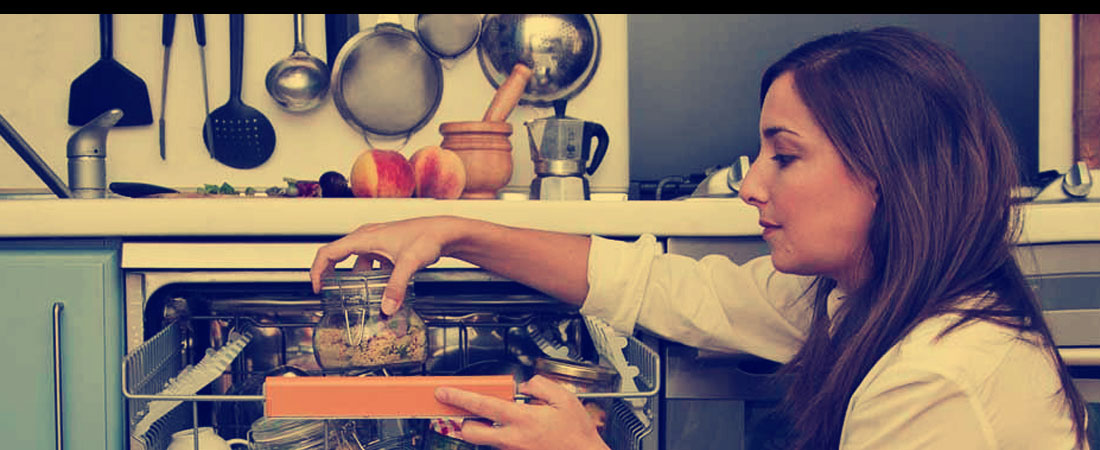Get the lowdown on this eco-friendly, energy-saving cooking trend that actually uses the dishwasher to prepare simple, nutritious, low-fat meals
 BY NABANITA DUTT
BY NABANITA DUTT
Did you know that `dishwasher cuisine’ is not just a possibility, but a verified method of eco-friendly cooking that is currently taking Italy by storm? And not even in an empty dishwasher – but in a fully loaded one, with dirty utensils and soap. The idea of food being prepared in a dishwasher is a bit hard to digest, like a wet pair of sneakers being dried off in a microwave, but if you stop to think about it, the whole thing does make some sort of absurd sense.
Every time you turn on your dishwasher, the appliance is using 1800 watts of electricity on an average to heat the water for cleaning.
So why not throw in some airtight containers or food vacuum bags with couscous, fish, veal, fruits etc and let them cook at the same time?
Imagine how much prepping it will save before meals, you won’t have to use your stove or oven, and you’ll get clean dishes, glasses, bowls and cutlery in the bargain.
It’s certainly an eco-aware way to maximize use of energy and minimizing time spent in the kitchen, and by all accounts, the food comes out tasting really good.
Ask Milan’s cook-cum-environmental-campaigner Lisa Casali, whose bestselling book Cucinare In Lavastoviglie (‘Cooking In The Dishwasher’) is converting thousands of Italians into enthusiastic dishwasher chefs.
 Lisa struck on this idea 7 years ago, when she began experimenting in her own kitchen with recipes that could be executed in airtight containers while the appliance was in cycle.
Lisa struck on this idea 7 years ago, when she began experimenting in her own kitchen with recipes that could be executed in airtight containers while the appliance was in cycle.
“Cooking and the environment are my greatest passions, and it really was a spontaneous urge to combine these two ingredients together,” says Lisa. “Just as if I were creating a new dish.”
Besides her obsession with dishwasher cooking, Lisa also propagates the nutritional value of so much precious food we throw out as scraps. She has 4 books to her credit and Ecocucinaen, a website where she journals her efforts in this unexplored, new culinary field.
And once you get over the gnawing mental visual of your dinner in a jar, bathing in wave after wave of soapy water with pasta particles and meat morsels floating past, you too might discover Lisa’s pioneering new world of cuisine that is quick, nutritious and a conversation piece.
Lisa has shared 4 of her favorite recipes with Bodmin Magazine, and also a fascinating guide that gives you all the tips and tricks you need to start dishwasher cooking today!
* If you’re inspired by Lisa’s cooking philosophy, you can buy her book Cucinare In Lavastoviglie (Cooking In The Dishwasher) right here.



PREPARATION:
The beef tagliata is well matched with many different vegetables, so choose your favorite.
In winter, you might want to try topinambour (also called Jerusalem artichoke) and cabbage, for example.
1) Chop the rosemary needles with the garlic cloves.
2) Rub the sirloin with half the chopped ingredients.
3) Place the meat in a vacuum pack bag and seal.
4) Place in the dishwasher and switch on Eco wash cycle.
5) Rinse the vegetables and slice finely.
6) Heat a tablespoon of oil in a pan with the other half of the chopped mixture. Add the vegetables and sauté.
Season with salt and pepper for about 5 minutes, then remove from fire and place in the fridge until you are ready to serve.
7) At the end of the wash cycle, place the sirloin in the fridge.
8) When you are ready to serve, heat a hot plate with a drizzle of oil.
9) Open the bag, and when the hot plate is really hot, brown the sirloin on all sides.
10) Reduce the cooking liquid in a saucepan to half; add salt if necessary.
Cut the beef sirloin in slices and serve with the reduction and the vegetables you have chosen.


PREPARATION:
1) Wash the mussels well, removing beards and any incrustations.
2) Place a pan on the stove with 2 tablespoons of oil, add the mussels and cook until they open.
3) Strain the cooking liquid and put it to one side.
4) Wash the lemons well and cut them into thin slices.
5) Put a slice on the bottom of each jar (if using 4 glass jars for 4 portions).
6) Shell half of the mussels. Divide the mussels (shelled or not) into the jars.
7) Leave the garlic cloves whole, crush them with a knife and insert one of them into each jar.
8) Add the strained cooking liquid from the mussels.
9) Add some freshly ground pepper.
10) Sprinkle a pinch of salt, the remaining lemon slices and chopped parsley.
11) Close the jars tightly and place them in the dishwasher.
12) When the cycle is over, serve hot and enjoy!

 PREPARATION
PREPARATION
1) Wash the tomatoes and cut them into small cubes.
2) Divide the diced tomatoes into 4 small jars.
3) Break open an egg in each jar, and then add the herbs, a spoon of olive oil, salt and pepper.
4) Tightly close the jars and place in the dishwasher in the empty space between your dirty dishes.
5) Insert the detergent as usual and start the `intensive washing’ program.
6) At the end of the washing, open the dishwasher and enjoy the eggs with slices of toasted bread.
6) If you do not want to consume immediately, store it in the refrigerator and heat in the microwave (without lid) for a few seconds.
The result is an amazingly creamy egg yolk and egg white.



